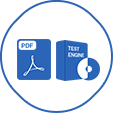Last Update 5 hours ago Total Questions : 100
The Certified Child and Family Resiliency Practitioner (CFRP) content is now fully updated, with all current exam questions added 5 hours ago. Deciding to include CFRP practice exam questions in your study plan goes far beyond basic test preparation.
You'll find that our CFRP exam questions frequently feature detailed scenarios and practical problem-solving exercises that directly mirror industry challenges. Engaging with these CFRP sample sets allows you to effectively manage your time and pace yourself, giving you the ability to finish any Certified Child and Family Resiliency Practitioner (CFRP) practice test comfortably within the allotted time.
A practitioner is completing an assessment with a child who recently experienced a traumatic event. The child is avoiding questions related to the event. The practitioner should
Emotional regulation can be acquired through
A practitioner engages and interacts in ways that invite a curious exploration of potential. This is anexample of which of the following approaches?
A transition-age youth tells a practitioner that he has a plan to kill a younger sibling when the time is right. What is the MOST appropriate course of action for the practitioner to take?
Assessment, planning, linking, and monitoring are core functions of
Between the ages of five and twelve years, a child is typically
The process for supporting students with mental health needs in an academic setting includes

